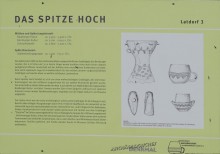|
|
|
|
Spitzes HochRound Barrow(s)
|
||||||||||||||||||
|
|
|
Images (click to view fullsize) |
|
Photographs: Maps / Plans / Diagrams:
Maps / Plans / Diagrams:
|
Fieldnotes |
|
|
The burial mound Spitzes Hoch is located about 280 meters south of the Steinerne Hütte, on the same dirt road. It is an impressive burial mound in an otherwise rather flat agricultural landscape. Visited April 2019 |
19th May 2019ce Edited 21st May 2019ce |
|
taken from the information board Arbeitskreis Archäologie im Bernburger Land e.V.: Das Spitze Hoch Middle and Late Neolithic Baalberg culture approx. 3,950 - 3,400 BC Bernburg culture approx. 3,100 - 2,650 BC Corded Ware culture approx. 2,800 - 2,200 BC Late Bronze Age Saale estuary group approx. 1,300 - 775 BC Spitzes Hoch (= tapered high) is one of the most impressive prehistoric burial mounds in the Bernburg region. The 6 m high and 31 m wide hill was built in the midst of an already largely open landscape on the hill of a glacial terminal moraine. Such an exposed location is characteristic of most of our prehistoric burial mounds, making them landmarks that can be seen from afar. Spitzes Hoch is a multi-layered burial mound that was used (intermittently) from the Middle Neolithic to the Late Bronze Age. The first grave at this place was built some 6,000 years ago by members of the so-called Baalberg culture. Thereafter, over a longer period of later cultures, burials were repeatedly created and the hill thereby gradually increased. Spitzes Hoch was the first archaeologically examined burial mound in the Bernburger Land. As early as 1880, excavations were carried out by professor Friedrich Klopffleisch, who at the time had the first chair of prehistory and early history in Germany at the University of Jena. Some characteristic finds were later together with finds from the burial mound Stockhof at Gröna eponymous for an archaeological group of the Middle Neolithic - the Bernburg culture. Among the notable finds of this culture were a decorated clay drum and charred woven fabric remnants, which are among the oldest Central Germany previously known textiles. The finds are kept today in the Museum Schloss Bernburg. |
19th May 2019ce Edited 21st May 2019ce |

